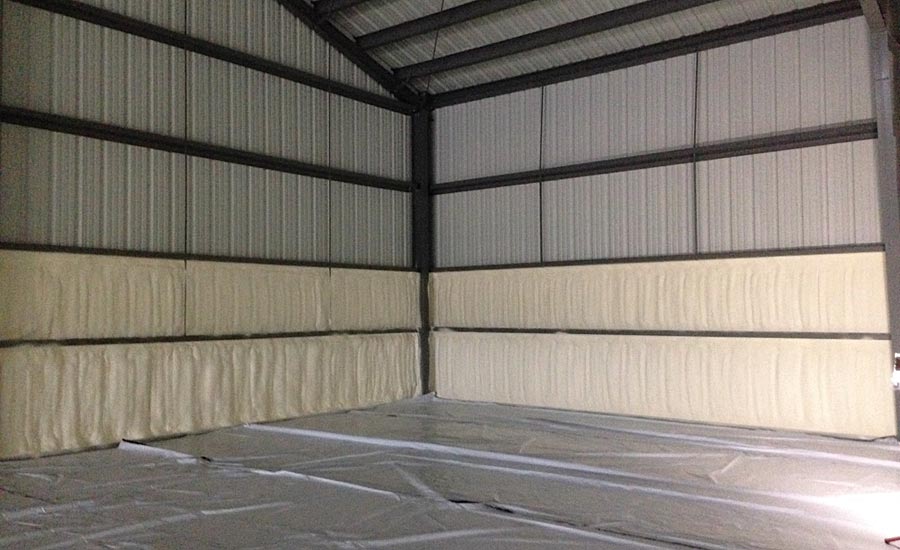Closed-cell spray foam offers measurable fire resistance due to its high-density structure, chemical formulation, and inclusion of flame-retardant additives. While it is not inherently fireproof, its design significantly slows the ignition and progression of flames and produces less smoke than many other materials. These attributes make it a trusted option for insulation in homes, commercial buildings, and industrial applications when installed according to code.
The most critical fire resistance features of closed-cell spray foam include its relatively high ignition temperature, its low flame spread index under ASTM E84 testing, and its compatibility with code-required thermal barriers. This article breaks down each component using data tables, relevant comparisons, and decision-support insights to help readers fully understand the material’s behavior in fire-related scenarios.
How Fire Resistance Works in Closed-Cell Spray Foam
Closed-cell spray foam is constructed from compact, rigid cells that contain trapped gas. These closed cells reduce airflow and limit oxygen availability, which in turn decreases the foam’s flammability. The dense foam matrix restricts flame penetration, while flame-retardant additives chemically delay ignition. This dual action of physical resistance and chemical suppression allows closed-cell spray foam to perform better than many alternative insulation types under fire conditions.
Additionally, when exposed to high temperatures, the surface of the foam chars rather than melting or dripping. This charing layer can slow additional combustion, adding another layer of passive protection.
Key Properties That Contribute to Fire Resistance
- High density: Minimizes oxygen diffusion and fuel availability
- Low flame spread index: Meets Class A rating under ASTM E84
- Embedded flame-retardant agents: Enhance ignition delay
- Low smoke production: Reduces inhalation risk during evacuation
- Char-forming characteristics: Creates a barrier during exposure

Technical Fire Resistance Specifications
| Property | Specification |
| Flame Spread Index (ASTM E84) | Typically <25 (meets Class A fire rating) |
| Smoke Developed Index | Usually <450 (meets code compliance) |
| Ignition Temperature | Around 700°F (370°C) |
| Thermal Conductivity | ~0.20 Btu-in/hr-ft²-°F |
| Density | 1.75 – 2.2 lb/ft³ |
| NFPA Compliance | Meets NFPA 286 with thermal barrier installation |
| Surface Charring Behavior | Self-limiting when fire is removed |
| Structural Integrity Retention | Partial, depending on exposure duration |
Fire Ratings Compared to Other Insulation Types
| Insulation Type | Flame Spread Index | Smoke Developed Index | Ignition Temp (approx) | Thermal Barrier Needed | Notable Fire Features |
| Closed-Cell Spray Foam | <25 | <450 | ~700°F | Yes | Char formation, chemical retardants |
| Open-Cell Spray Foam | 75-200 | 400-500 | ~650°F | Yes | Less dense, faster ignition |
| Fiberglass Batt | 0 | 0 | Non-combustible | Often not required | Inorganic, naturally fire resistant |
| Cellulose (Treated) | ~30 | ~250 | ~400°F | Sometimes | Borate treatment improves resistance |
| Mineral Wool | 0 | 0 | >1000°F | Rarely required | Extremely fire-resistant |
Code Compliance and Installation Standards
All spray foam insulation systems are subject to fire safety codes. Closed-cell foam, in particular, must be covered with a thermal barrier such as 1/2-inch gypsum wallboard or an equivalent material. This barrier is not just a formality—it significantly delays the temperature rise that can lead to ignition.
According to the International Building Code (IBC) and International Residential Code (IRC), exposed spray foam in habitable spaces, garages, crawl spaces, or attics must either be separated by a prescriptive barrier or have tested approval under NFPA 286 for alternate assemblies. Some specialty products incorporate intumescent coatings, which expand under heat and provide barrier-like protection without traditional drywall.
Market Data Snapshot
- IBISWorld reports that the U.S. spray foam insulation market will surpass $2.3 billion by 2026, driven in part by evolving fire safety mandates.
- More than 80% of commercial structures specify closed-cell spray foam in fire-rated assemblies due to its superior performance metrics.
- NFPA and ICC reports show a rise in third-party tested assemblies using closed-cell spray foam, especially in multifamily and healthcare construction.
Things to Consider Before Making a Decision
- Location of Installation: Enclosed cavities may require different barrier strategies than exposed installations.
- Access and Maintenance: Areas that may need future inspection should use foam in conjunction with removable barriers.
- Fire Safety Objectives: Determine whether the goal is passive delay or full fire containment.
- Barrier Type and Placement: Not all barriers offer equal protection; use only code-approved options.
- Product Certification: Confirm listings with ICC-ES, UL, or local building authorities.
- Additive Composition: Some foams use halogenated additives, which may raise environmental concerns.
Bonus Tip
If your project involves unusual geometries, such as steel framing or irregular crawlspaces, verify that your selected closed-cell foam has been tested in comparable assemblies.
Common Questions
Can closed-cell foam be left exposed in a garage?
No. All garage installations must meet code fire safety requirements. Drywall or an approved intumescent coating must cover exposed foam.
Is closed-cell foam fireproof?
No. It resists ignition and slows fire spread but still burns under direct, prolonged exposure.
What happens if it’s exposed to direct flame?
It chars on the surface and resists flame for a time, but will eventually degrade and contribute to fire growth if unprotected.
Does it produce harmful smoke?
Compared to other polymers, closed-cell foam generates lower volumes of smoke and contains fewer toxic gases, but some emissions do occur.
Bonus Tip
Install smoke detectors and fire-rated egress solutions near foam-insulated areas, particularly in attics and basements.
Topic FAQ
Is closed-cell spray foam a good choice for fire-prone areas?
Yes, as long as it’s used with approved barriers. Its ability to slow flame travel can protect structural elements.
Does the foam release toxic fumes when it burns?
In low volumes, yes. It produces fewer toxins than many foams, but protective barriers remain essential.
Do all closed-cell foams meet the same standards?
No. Performance varies by brand and formulation. Look for ASTM E84 and NFPA 286 compliance.
What thermal barrier is most commonly used?
1/2-inch gypsum wallboard is the most widely accepted barrier in U.S. codes.
Are there closed-cell options with enhanced fire ratings?
Yes. Some are pre-treated or include intumescent layers to meet advanced fire codes without traditional barriers.
Make the Right Decision
Closed-cell spray foam is a high-performance material offering advanced fire resistance when properly applied. However, its effectiveness depends on full compliance with fire safety codes, including barrier installation and certified testing. It is not a substitute for fireproofing systems but can be a valuable part of a complete fire resistance strategy. Take the time to evaluate the material properties, local code requirements, and third-party certifications before selecting a product. Engage professionals with expertise in both spray foam installation and fire safety to ensure long-term protection.
Reviewer: Lily Johnson offered her feedback after reviewing this post. With 8 years in the spray foam insulation field, her suggestions centered around improving outreach to homeowners looking for quality insulation solutions.
Call: (541) 826-9600
visit us: All Foam & Insulation






